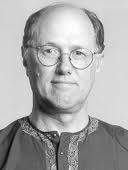THE UNIVERSE: GREAT THOUGHT OR GREAT MACHINE?
by George Wolfe
 Today we hear a lot about inflation, mostly in the context of economics. But inflation has also found its way into modern cosmology.
Today we hear a lot about inflation, mostly in the context of economics. But inflation has also found its way into modern cosmology.
According to the Big Bang theory, in the beginning all the matter in the universe was packed into a very small volume of infinite mass and density. Astrophysicists refer to the universe just before the Big Bang as a “singularity.” This is a null-dimensional state of infinite gravity. Even time and space were compressed within this singularity.
When we see the Big Bang depicted on television or on a movie screen, we see a huge explosion of matter and light that fills up the empty dark screen. But this animation is actually a misrepresentation of the primordial event. For in the beginning, there was no space to be filled. Nor was there initially any light breaking forth, because for the first 300,000 years, scientists theorize that the universe was dark.
Scientists are now describing the “Big Bang” as an expansion or unfolding of time and space, more like a balloon that is being inflated.
This inflationary model raises the following questions. Is the space-time continuum we experience merely a mental conception we construct to help us have some understanding of our universe? Or should space-time be thought of as something that is created, existing on the skin of the balloon and having its own ontological existence? If it is a mental conception, then space-time cannot exist independent of mind. Its reality requires a mind to conceive it. On the other hand, if it is something that is created and expanding by virtue of the initial inflation of the universe, then we are left with a perplexing koan-like riddle asked by theologian John Denker. In his book The Quantum God, Denker asks, if the universe is expanding like a balloon in which time and space only exist in the skin of the balloon, “what is the balloon [i.e. space and time] expanding into?”
Experiments in quantum physics demonstrate that a wave behaves like a particle only when an interaction is being observed or recorded. Electrons and photons, for example, behave as if they know they are being watched.
Both modern astrophysics and quantum mechanics force us to admit that everything, including mind and matter, is interrelated and interdependent. One cannot exist without the other. We cannot get outside our awareness, our consciousness. The universe is expanding into the collective universal mind of which we are a part and microcosm. The words of astronomer Carl Sagan come to mind, when he said in the opening episode of his television series Cosmos, “we are a way the cosmos can know itself.”
Without the presence and interaction with something that observes or records their interaction, waves on the quantum level would not collapse to become particles. Without consciousness, ideas could not form, take shape and become reality, and the primordial null-dimensional singularity, as incomprehensible and abstract as that concept is, would not have been conceivable.
Astronomer Sir James Hopwood Jeans, who did pioneering work in both astrophysics and quantum mechanics, said it best: “The universe seems to be nearer to a great thought than a great machine.”
George Wolfe is the Coordinator of Outreach Programs for the Ball State University Center for Peace and Conflict Studies. He also chairs the Muncie Interfaith Fellowship, is a trained mediator, and the author of The Spiritual Power of Nonviolence: Interfaith Understanding for a Future Without War.


